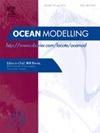高模近惯性波对台风诱发的南海海面温度冷却增强的贡献
IF 2.9
3区 地球科学
Q2 METEOROLOGY & ATMOSPHERIC SCIENCES
引用次数: 0
摘要
海面温度冷却(SSTC)是海洋对台风反应的一个重要指标,也是台风演变的一个因素。了解不同台风诱发 SSTC 的复杂机制非常重要。基于数值模拟,我们研究了台风 "鲇鱼"(2010 年)、"玲花"(2015 年)和 "莎莉嘉"(2011 年)诱发的 SSTC。作为最强(最弱)的台风,鲇鱼(莎莉嘉)诱发的 SSTC 最大(最小),这与强台风通常比弱台风诱发更大 SSTC 的传统认识一致。然而,中等强度台风 "莲花 "诱发的 SSTC 几乎与 "鲇鱼 "相当,而 "莲花 "的风能输入却比 "鲇鱼 "小一个数量级。对 "玲花 "和 "鲇鱼 "引起的近惯性波(NIWs)进行的比较表明,前者含有较大比例的高模式,对垂直切变有很大的影响。因此,"林法 "期间的垂直混合系数达到了 "鲇鱼 "期间的三分之一。由于 SSTC 主要受垂直混合的影响,而垂直混合又以混合层深度的垂直扩散为主,因此,Linfa 期间相对较强的垂直混合系数和较大的温度梯度最终导致 SSTC 几乎与 Megi 期间诱发的 SSTC 相当。本研究的结果加深了人们对台风诱发的 SSTC 的理解。本文章由计算机程序翻译,如有差异,请以英文原文为准。
Contribution of high-mode near-inertial waves to enhanced typhoon-induced sea surface temperature cooling in the South China Sea
Sea surface temperature cooling (SSTC) is an important indicator of the ocean response to typhoons and is a factor in the evolution of typhoons. Understanding the intricate mechanisms underlying the SSTC induced by different typhoons is important. Based on the numerical simulation, we investigated the SSTC induced by typhoons Megi (2010), Linfa (2015), and Sarika (2011), which had relatively similar tracks in the South China Sea. As the strongest (weakest) typhoon, Megi (Sarika) induced the largest (smallest) SSTC, which is consistent with the traditional understanding that stronger typhoons usually induce larger SSTC than weaker typhoons. However, the SSTC induced by the moderate typhoon Linfa was nearly comparable to that induced by Megi, while Linfa had a wind power input an order of magnitude smaller. A comparison of near-inertial waves (NIWs) induced by Linfa and Megi showed that the former contained a larger proportion of high modes, substantially contributing to vertical shear. Consequently, the vertical mixing coefficient during Linfa reached one third of that during Megi. Because the SSTC is primarily influenced by vertical mixing, which is dominated by vertical diffusion at the mixed layer depth, the relatively strong vertical mixing coefficient and large temperature gradient during Linfa ultimately resulted in the SSTC nearly comparable to that induced by Megi. The results of this study enhance the understanding of typhoon-induced SSTC.
求助全文
通过发布文献求助,成功后即可免费获取论文全文。
去求助
来源期刊

Ocean Modelling
地学-海洋学
CiteScore
5.50
自引率
9.40%
发文量
86
审稿时长
19.6 weeks
期刊介绍:
The main objective of Ocean Modelling is to provide rapid communication between those interested in ocean modelling, whether through direct observation, or through analytical, numerical or laboratory models, and including interactions between physical and biogeochemical or biological phenomena. Because of the intimate links between ocean and atmosphere, involvement of scientists interested in influences of either medium on the other is welcome. The journal has a wide scope and includes ocean-atmosphere interaction in various forms as well as pure ocean results. In addition to primary peer-reviewed papers, the journal provides review papers, preliminary communications, and discussions.
 求助内容:
求助内容: 应助结果提醒方式:
应助结果提醒方式:


